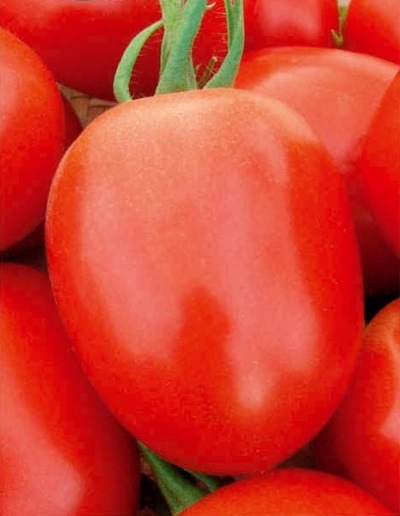
- Authors: Kachainik V.G., Gulkin M.N., Karmanova O.A., Matyunina S.V.
- Year of approval: 2018
- Category: hybrid
- Growth type: determinant
- Appointment: fresh consumption
- Ripening period: early
- Ripening time, days: 90-100
- Growing conditions: for open ground, for film greenhouses
- Bush size: undersized
- Bush characteristic: compact
Determinant tomato Salting miracle refers to undersized compact tomatoes. The versatile hybrid is intended for cultivation in the open field and in greenhouses, but this position can hardly be considered appropriate. Its early maturity makes it possible to harvest in the open field even in the short Siberian summer, while many other varieties need shelter, especially large-fruited with medium-late and late fruiting dates. Tomatoes are consumed fresh and for canning.
Breeding history
The hybrid is a relative newcomer to the orchards and gardens of Russians. It was included in the State Register of Breeding Achievements in 2018. The originators of the Salting Miracle are the Ural breeders V. G. Kachainik, M. N. Gulkin, O. A. Karmanova, S. V. Matyunina.
Description of the variety
Low-growing compact bushes (50-60 cm) are covered with long green leaves. The yellow flowers are collected in complex inflorescences, forming a good cluster with many ovaries. The fruits are attached to the stalk without joints.
The main qualities of the fruit
Elliptical slightly ribbed dark green immature fruits acquire a beautiful bright red color at the stage of technical and physiological ripeness. Lined tomatoes weigh 95-100 g, making them ideal for whole-fruit canning.
Taste characteristics
Salted miracle has a classic tomato flavor - balanced sugars and acidity make the taste of the fruit in the marinade amazing. They are no less tasty in summer salads. The dense flesh is covered with a tough skin that prevents cracking during canning.
Ripening and fruiting
The hybrid belongs to early ripening tomatoes. Harvesting begins approximately three months after sowing - 90-110 days.
Yield
The salting miracle gives a good harvest from one square meter - up to 11 kilograms.
The timing of planting seedlings and planting in the ground
The timing of sowing seeds is traditional for most varieties - 55-60 days before planting in open ground.

Growing tomato seedlings is an extremely important process, because it largely depends on whether the gardener can harvest at all. All aspects must be taken into account, from seedbed preparation to planting in the ground.
Landing scheme
Limited growth allows you to plant plants quite tightly - up to 6 plants are placed on one square meter, with a distance between the roots of 30 cm, and 50 centimeters between rows. This is the optimal format for low growing tomatoes.

Growing and care
The Salting miracle is grown in the traditional seedling way. Two weeks before the transfer of plants to a permanent place, the seedlings are hardened - they are accustomed to outdoor temperature and lighting. A place for landing is chosen sunny, preferably protected from drafts and cold winds. Thus, the tomato in the open field will have time to fully yield the crop. Onions, carrots, and legumes are good predecessors of the tomato crop. The plot begins to be prepared in the fall, when manure is brought in for digging. Acidic soils are deoxidized with bone or dolomite flour, lime, chalk, wood ash, green manure.
In the spring, organic matter is added to the holes in the form of humus, compost or bird droppings, complex mineral fertilizers, and wood ash. Low-growing plants do not need support, as well as pinching, which greatly facilitates the gardener's task. The bush is formed into 1-2 stems. All further care is no different from traditional methods. Timely, but infrequent watering until the moment when mass ripening begins. After that, humidification is minimized or completely stopped. Top dressing in the spring, when plants need nitrogen to build up green mass, during budding and after phosphorus-potassium fertilizers. Throughout the season, tomatoes are fed with "green tea" - a fermented infusion of nettle and other herbs with the addition of bread leftovers. Tomatoes are also actively developing after the introduction of a diluted fresh mullein.




A plant needs different micronutrients at each stage of growth. All fertilizers can be divided into two groups: mineral and organic. Folk remedies are often used: iodine, yeast, bird droppings, eggshells.
It is important to observe the rate and period of feeding. This also applies to folk remedies and organic fertilizers.
Disease and pest resistance
Tomato has a strong immune system, and therefore is resistant to most diseases inherent in nightshade crops. Moreover, the peculiarity of the Salting miracle is that its foliage releases phytoncides, and this scares away many pests. However, phytoncides will not ward off Colorado and May beetles from tasty tops, so you need to carefully monitor the plants, if necessary, collect pests by hand or treat the plantings with insecticides.


Resistant to adverse weather conditions
The variety intended for open ground copes well with summer temperature extremes, short-term droughts or rains. Frosts are dangerous for him, but his early maturity allows him to harvest to critical levels.
Growing regions
The hybrid is adapted for all regions of Russia. It is grown in warm regions, such as the Central Black Earth Region, the North Caucasus, the Middle Volga and Lower Volga districts. Salting miracle is also cultivated in a more risky and colder climate - the northern, northwestern, central, Volgo-Vyatka, Ural, West Siberian, East Siberian and Far Eastern regions.

























































































